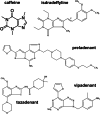The belated US FDA approval of the adenosine A2A receptor antagonist istradefylline for treatment of Parkinson's disease
- PMID: 32236790
- PMCID: PMC7367999
- DOI: 10.1007/s11302-020-09694-2
The belated US FDA approval of the adenosine A2A receptor antagonist istradefylline for treatment of Parkinson's disease
Abstract
After more than two decades of preclinical and clinical studies, on August 27, 2019, the US Food and Drug Administration (FDA) approved the adenosine A2A receptor antagonist Nourianz® (istradefylline) developed by Kyowa Hakko Kirin Inc., Japan, as an add-on treatment to levodopa in Parkinson's disease (PD) with "OFF" episodes. This milestone achievement is the culmination of the decade-long clinical studies of the effects of istradefylline in more than 4000 PD patients. Istradefylline is the first non-dopaminergic drug approved by FDA for PD in the last two decades. This approval also provides some important lessons to be remembered, namely, concerning disease-specific adenosine signaling and targeting subpopulation of PD patients. Importantly, this approval paves the way to foster entirely novel therapeutic opportunities for adenosine A2A receptor antagonists, such as neuroprotection or reversal of mood and cognitive deficits in PD and other neuropsychiatric diseases.
Keywords: A2A receptor; Adenosine; KW6002; Parkinson’s disease; clinical trial; istradefylline; safety; therapy.
Conflict of interest statement
Dr. Jiang-Fan Chen declared no conflict of interest.
R.A. Cunha is a scientific consultant to ISIC – Institute for Scientific Information on Coffee.
Figures
Similar articles
-
Istradefylline: adenosine A2A receptor antagonist to reduce "OFF" time in Parkinson's disease.Drugs Today (Barc). 2020 Feb;56(2):125-134. doi: 10.1358/dot.2020.56.2.3098156. Drugs Today (Barc). 2020. PMID: 32163528 Review.
-
Istradefylline - a first generation adenosine A2A antagonist for the treatment of Parkinson's disease.Expert Rev Neurother. 2021 Mar;21(3):317-333. doi: 10.1080/14737175.2021.1880896. Epub 2021 Feb 22. Expert Rev Neurother. 2021. PMID: 33507105 Review.
-
Targeting the adenosine A2A receptor for neuroprotection and cognitive improvement in traumatic brain injury and Parkinson's disease.Chin J Traumatol. 2024 May;27(3):125-133. doi: 10.1016/j.cjtee.2023.08.003. Epub 2023 Aug 25. Chin J Traumatol. 2024. PMID: 37679245 Free PMC article. Review.
-
Occupancy of adenosine A2A receptors by istradefylline in patients with Parkinson's disease using 11C-preladenant PET.Neuropharmacology. 2018 Dec;143:106-112. doi: 10.1016/j.neuropharm.2018.09.036. Epub 2018 Sep 22. Neuropharmacology. 2018. PMID: 30253174 Clinical Trial.
-
A2A Adenosine Receptor Antagonists and their Potential in Neurological Disorders.Curr Med Chem. 2022 Aug 6;29(28):4780-4795. doi: 10.2174/0929867329666220218094501. Curr Med Chem. 2022. PMID: 35184706 Review.
Cited by
-
New MiniPromoter Ple389 (ADORA2A) drives selective expression in medium spiny neurons in mice and non-human primates.Sci Rep. 2024 Nov 15;14(1):28194. doi: 10.1038/s41598-024-79004-y. Sci Rep. 2024. PMID: 39548191 Free PMC article.
-
Novel perspective of therapeutic modules to overcome motor and nonmotor symptoms in Parkinson's disease.AIMS Neurosci. 2024 Sep 6;11(3):312-340. doi: 10.3934/Neuroscience.2024020. eCollection 2024. AIMS Neurosci. 2024. PMID: 39431269 Free PMC article. Review.
-
Trends on Novel Targets and Nanotechnology-Based Drug Delivery System in the Treatment of Parkinson's disease: Recent Advancement in Drug Development.Curr Drug Targets. 2024;25(15):987-1011. doi: 10.2174/0113894501312703240826070530. Curr Drug Targets. 2024. PMID: 39313872 Review.
-
Control of Dopamine Signal in High-Order Receptor Complex on Striatal Astrocytes.Int J Mol Sci. 2024 Aug 7;25(16):8610. doi: 10.3390/ijms25168610. Int J Mol Sci. 2024. PMID: 39201299 Free PMC article.
-
Drug Development for Alzheimer's and Parkinson's Disease: Where Do We Go Now?Pharmaceutics. 2024 May 24;16(6):708. doi: 10.3390/pharmaceutics16060708. Pharmaceutics. 2024. PMID: 38931832 Free PMC article. Review.
References
-
- Amin N, Byrne E, Johnson J, Chenevix-Trench G, Walter S, Nolte IM, kConFab Investigators. Vink JM, Rawal R, Mangino M, Teumer A, Keers JC, Verwoert G, Baumeister S, Biffar R, Petersmann A, Dahmen N, Doering A, Isaacs A, Broer L, Wray NR, Montgomery GW, Levy D, Psaty BM, Gudnason V, Chakravarti A, Sulem P, Gudbjartsson DF, Kiemeney LA, Thorsteinsdottir U, Stefansson K, van Rooij FJ, Aulchenko YS, Hottenga JJ, Rivadeneira FR, Hofman A, Uitterlinden AG, Hammond CJ, Shin SY, Ikram A, Witteman JC, Janssens AC, Snieder H, Tiemeier H, Wolfenbuttel BH, Oostra BA, Heath AC, Wichmann E, Spector TD, Grabe HJ, Boomsma DI, Martin NG, van Duijn CM. Genome-wide association analysis of coffee drinking suggests association with CYP1A1/CYP1A2 and NRCAM. Mol Psychiatry. 2012;17:1116–1129. - PMC - PubMed
-
- Ascherio A, Schwarzschild MA. The epidemiology of Parkinson's disease: risk factors and prevention. Lancet Neurol. 2016;15:1257–1272. - PubMed
-
- Ascherio A, Zhang SM, Hernán MA, Kawachi I, Colditz GA, Speizer FE, Willett WC. Prospective study of caffeine consumption and risk of Parkinson's disease in men and women. Ann Neurol. 2001;50:56–63. - PubMed
-
- Brooks DJ, Papapetropoulos S, Vandenhende F, Tomic D, He P, Coppell A, O'Neill G. An open-label, positron emission tomography study to assess adenosine A2A brain receptor occupancy of vipadenant (BIIB014) at steady-state levels in healthy male volunteers. Clin Neuropharmacol. 2010;33:55–60. - PubMed
Publication types
MeSH terms
Substances
LinkOut - more resources
Full Text Sources
Other Literature Sources



